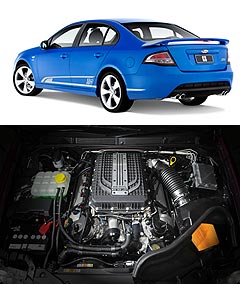New models - FPV - GSFPV's blown V8 range priced from under $57KShe'll be white: FPV's GS comes in 11 exterior colour choices, with side and bonnet stripes. FPV’s new entry-level supercharged GS undercuts HSV rival by more than $10,0005 Oct 2010 FORD Performance Vehicles today launched its 2011 range of supercharged Falcon models, announcing new entry-level prices of $51,990 (plus on-road costs) for the GS Ute and $56,990 for the GS sedan, both which have now been confirmed as full-time members of the upgraded FPV model family. That makes the least expensive model within FPV’s upgraded V8 range – powered by a lighter new Australian-developed and locally assembled all-alloy supercharged 5.0-litre DOHC 32-valve ‘Miami' version of Ford's new global 'Coyote' engine – some $10,900 cheaper than the turbocharged 4.0-litre six-cylinder F6 sedan ($67,890), as well as $7000 more affordable than the F6 Ute ($58,990). Like all FPVs except the top-shelf GT-E sedan, a six-speed automatic transmission will be a no-cost option for both versions of the GS, which is powered by a 315kW/545Nm version of FPV’s first-ever supercharged engine, eclipsing the performance of FPV’s previous 5.4-litre GT flagship.  Left: FPV GS sedan. Below: FPV 5.0-litre supercharged V8. Left: FPV GS sedan. Below: FPV 5.0-litre supercharged V8.In the absence of the limited-edition GXP from HSV’s 2010 E3 range, FPV’s permanent new GS sedan model – which follows the success of a similarly-named limited-edition model in late 2009 – undercuts its most direct rival in the entry-level ClubSport R8 sedan ($67,600) by more than $10,600, even before HSV buyers tick the $2000 automatic option box. However, at $71,290, FPV’s 2011 GT – whose 335kW/570Nm version of the blown Coyote V8 betters the 325kW/550Nm outputs of HSV’s top-spec 6.2-litre V8 – is $3200 more than the 5.4-litre model it replaces, while the $80,990 GT-P is $2250 more than before and the auto-only GT-E flagship ($81,450) increases by $1710. There is no replacement for FPV’s Pursuit or Super Pursuit utes because their leaf-sprung live axle simply wouldn’t have coped with the performance of the new top-shelf V8, nor is there any sign of 2011 XR8 models from Ford. Stocks of the outgoing 5.4-litre XR8 sedan and ute – which was last priced $600 lower than the upgraded 2010 XR6 Turbo in sedan guise at $48,390 – have all but run dry and buyers in the market for a Coyote V8-engined successor are likely to have to wait until mid-2011. “Last year’s limited-edition GS simply reinforced what we suspected, that there is absolutely a market for an entry-level FPV model,” said FPV general manager Rod Barrett. “The GS provides our customers with a more affordable entry into the range. It broadens the market for potential FPV purchasers and at the same time delivers tremendous value. “Perhaps the most exciting thing about our new GS is that, while it matches the output of our previous Boss 5.4-litre V8, it actually smoothly outperforms it in every way. “It’s faster and it’s more fuel efficient but, perhaps most importantly, the supercharged configuration provides a tremendous ‘drive’… this is a fun car and we think it’s going to be enormously successful for us.” The new GS models continue with the limited-edition model’s stripe graphics at the bottom of the doors, and gain bonnet stripes with ‘Boss 315’ badging, five-spoke alloy wheels with a silver rather than graphite finish, and FPV branding on the steering wheel, instrument cluster, and new-design build badge. GS models will be available with three interior trim options, three contrasting stripe colour options and 11 exterior paint colours (10 for the ute). As we've reported, FPV's $40 million Boss V8, which features a locally assembled top-ens with Harrop Engineering-developed supercharger employing Eaton TVS technology, is 45kg lighter than the 5.4 Boss it replacesAlong with producing 315kW of power at 5750rpm and 545Nm of torque between a wide 2000 to 5500rpm, the GS manual Sedan returns official ADR 81/02 fuel consumption of 13.6 litres per 100km and CO2 emissions of 324 grams per kilomeetre, while the GS auto sedan returns 13.7L/100km and 325g/km. The GT-spec engine produces 335kW at 5750-6000rpm and 570Nm between 2200 and 5500rpm, while returning the same fuel comsumption and CO2 emissions as the 315kW engine in the GT, GT-P and GT-E.
 Read moreAll new models Alfa Romeo Alfa Romeo Abarth Abarth Audi Audi Aston Martin Aston Martin BMW BMW Bentley Bentley Chrysler Chrysler Chevrolet Chevrolet Dodge Dodge Citroen Citroen Ferrari Ferrari DS DS Ford Ford Fiat Fiat FPV FPV Foton Foton Haval Haval Great Wall Great Wall Honda Honda Holden Holden Hyundai Hyundai HSV HSV Isuzu Isuzu Infiniti Infiniti Jeep Jeep Jaguar Jaguar Lamborghini Lamborghini Kia Kia Lexus Lexus Land Rover Land Rover Mazda Mazda Maserati Maserati Mercedes-Benz Mercedes-Benz McLaren McLaren Mini Mini Nissan Nissan Mitsubishi Mitsubishi Peugeot Peugeot Opel Opel Proton Proton Porsche Porsche Renault Renault Ram Ram Saab Saab Rolls-Royce Rolls-Royce Smart Smart Skoda Skoda Subaru Subaru SsangYong SsangYong Tesla Tesla Suzuki Suzuki Toyota Toyota Volvo VolvoMotor industry news |
|
||||||||||||||||||||||||||||||
















Facebook Twitter Instagram